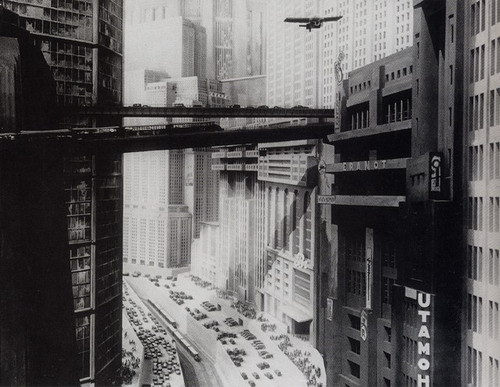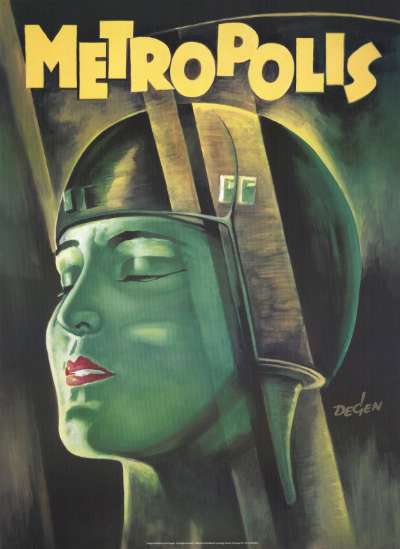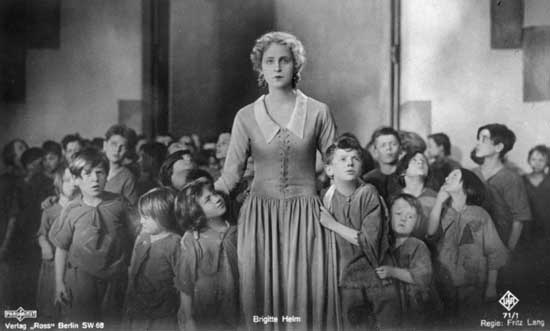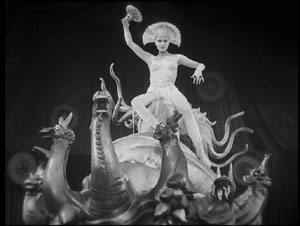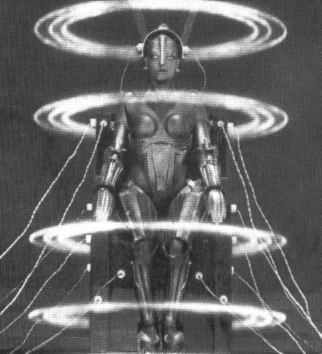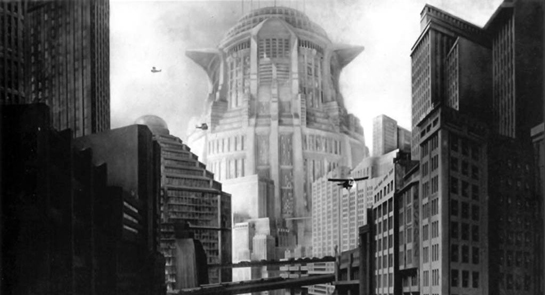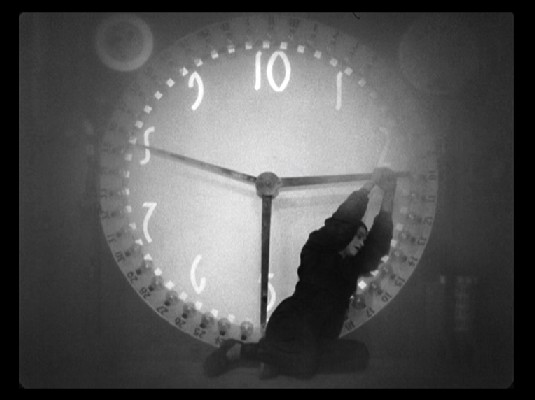This appeared in the August 16, 2002 issue of the Chicago Reader. I more recently had occasion to return to this film and some of my thoughts about it when I joined David Kalat to do an audio commentary on the expanded (and now nearly complete) version of Metropolis for the English DVD of Masters of Cinema. In fact, the essay below was used by Masters of Cinema in the accompanying booklet of their previous edition of the film, and an updated version of this piece appeared in the next one. — J.R.
Metropolis
**** (Masterpiece)
Directed by Fritz Lang
Written by Lang and Thea von Harbou
With Gustav Frohlich, Brigitte Helm, Alfred Abel, Rudolf Klein-Rogge, Fritz Rasp, Theodor Loos, and Heinrich George.
The internationalism of filmic language will become the strongest instrument available for the mutual understanding of peoples, who otherwise have such difficulty understanding each other in all too many languages. To bestow upon film the double gift of ideas and soul is the task that lies before us.
We will realize it! — Fritz Lang, in an article published in 1926
Lang’s utopian rallying cry, written in Germany during the editing of Metropolis, is well worth recalling today. It’s relevant as an acknowledgment of the lack of mutual understanding between nations that currently threatens our planet — and by extension, of the lack of mutual understanding between classes that threatens our country and planet. And it’s relevant as a double-edged expression of hope (“We will realize it!”) and despair (“such difficulty understanding each other in all too many languages”) — responses that form the warp and woof of Metropolis itself. Yet Lang’s dream of mutual understanding between nations seems to have distracted him from finding a satisfactory resolution of class issues in Metropolis, much as the xenophobic warmongering of the Bush administration is distracting Americans from a legitimate class resentment of recent capitalist swindles.
Metropolis — a 75th-anniversary reconstruction of which is showing at the Music Box this week — was scripted by Lang and his wife at the time, Thea von Harbou. She became a Nazi, stayed behind when Lang left Germany in the early 30s, and wrote the novel Metropolis, said to be one of the best guides to what the original film was like. The dreams and nightmares that made Hitler and Goebbels fans taint the film in some ways, though it continues to function as an alluring yet impenetrable object — a kind of camp tragedy that has a ridiculous happy ending but, apart from 2001: A Space Odyssey, remains the most ambitious science fiction film ever made.
In its own time Metropolis was clearly more of an event than Kubrick’s masterwork was in 1968 — an attempt to beat Hollywood at its own game that took well over a year to shoot, reportedly used up to 30,000 extras, and sabotaged the career of the most talented and prestigious producer of silent German cinema, Erich Pommer, who lost his job at UFA after the film went so far over budget it could never earn back its investment. The astonishing thing is that Metropolis seems much more relevant to current events than 2001, which assumed that the cold war would still be going on. Metropolis emphasizes not merely class divisions, but the emotional confusion underlying the creation of androids — also a major theme of A.I. Artificial Intelligence. 2001 dramatizes some of the same confusion, but the female robot in Metropolis, the false Maria, has much more in common with A.I.‘s Gigolo Joe than she (or it) has with 2001‘s talking computer HAL (though someone ought to examine HAL’s and Gigolo Joe’s sexual ambiguities).
Most people’s notion of Metropolis as a primordial SF film, mine included, has been distorted because so much of the plot and underlying conception of the film were cut by UFA and Paramount Pictures, the American distributor, a few weeks after its German premiere. The original version was later lost, and so the American version is the one we have had to see. In it all the references to one major offscreen character — the hero’s mother, who died giving birth to him and was once a source of rivalry between Joh Fredersen (Alfred Abel), his tycoon father and ruler of Metropolis, and Rotwang (Rudolf Klein-Rogge), an inventor who later builds a robot modeled on her — were elided by an American editor who decided that her name, Hel, would make American viewers think of “hell” and who said he didn’t understand that part of the plot anyway. Other changes created more imbalances and confusion, including cuts that favored the film’s expressions of hope over its expressions of despair.
The original version ran 153 minutes (assuming a projection speed of 24 frames per second, the speed later used for sound films). This latest reconstruction, the longest version now available, is 29 minutes shorter, though some of the new running time is taken up by intertitles that have been added to summarize parts that are still missing. Yet thanks to those intertitles and the addition of over a half hour of new footage since the first “modern” restoration of the film, in 1972 (and almost 15 minutes more than the invaluable, if rarely seen in the U.S., 1987 restoration Enno Patalas did for the Munich Film Archive), we finally have a fair approximation of the original, complete with the original score.
Not that the film was a flawless masterpiece in 1927. Indeed, Metropolis has one of the lamest endings of any great film I can think of, and this has survived intact in virtually all of the intermediate versions — a dopey reconciliation between management (Joh) and “labor” (ludicrously represented by an informer employed by Joh) brought about by the soulful hero, Freder (Gustav Frohlich), with the encouragement of the angelic Maria (Brigitte Helm) that illustrates the film’s opening and closing motto, “The mediator between brains and hands must be the heart!” The sappy ending might be partially the result of pandering to the American market, but it might also be simply a casualty of the mind-set that favors symmetry of design over political smarts and common sense. This ending, the generally wimpy Freder (a sensitive youth in knickerbockers who seems ready to faint at regular intervals), and a lot of confusing plot points have led most critics to regard the film as irredeemably silly, even when they admire the breathtaking visuals. Lang’s own disparagement of the film did nothing to discourage this verdict.
But as the longer version shows, however naive the film’s socialist notions might be — most of them are built around Freder’s belated discovery that his father exploits workers — its post-Freudian contours and narrative conceits remain highly sophisticated. This is apparent in the structure of the city, where the repressed workers labor underground while the wealthy enjoy their patriarchal preeminence and sexual frolics above ground. It’s even more apparent in the Oedipal traumas undergone by Freder and in the matching pairs of good father (Joh) and bad father (Rotwang) and good mother (Maria) and bad mother (the false, robot Maria); Hel fuses the other two mother figures by serving as the inspiration for the robot Maria after having died giving birth to Freder. (Women in this scenario are either madonnas or whores, just as men are either corrupted fathers or innocent sons. The 17-year-old Helm, who plays both Marias, registers this duality so powerfully that one can easily see why she was Josef von Sternberg’s first choice for the female lead in The Blue Angel a few years later — a part that went to Marlene Dietrich only after Helm refused it.)
Joh orders Rotwang to construct the robot in Maria’s image in order to sabotage her revolutionary mission — a ploy roughly analogous to the FBI’s infiltration of radical groups in the 60s — but he doesn’t realize that Rotwang carries out this project as a way of vengefully driving a wedge between Joh and his son. No villain in the story is entirely a villain, which was already half evident in earlier versions of the film. But the clarified function of Hel and of several minor characters makes this and everything else hang together for the first time since the Berlin premiere.
I was set up for a serious reevaluation of the film once I read Tom Gunning’s brilliant defense of it in his 2000 book The Films of Fritz Lang: Allegories of Vision and Modernity, and much of my preceding interpretation derives directly from his analysis. Maintaining that some of the film’s poor critical reputation stems from its use of allegory — bearing in mind that “modern critical commentary on allegory began as condemnation,” starting with Goethe — Gunning emphasizes the clash between Gothic and modern imagery in the film, “which often displaces the more manifest conflict between classes.”
This is perhaps most obvious in Rotwang’s medieval-looking cottage, an anachronism lodged in the center of the city of Metropolis; its dank cellar and passageways lead to even danker catacombs under the city, where the workers attend secret revolutionary meetings led by either Maria (madonna) or, later on, the false Maria (whore). But it seems equally obvious in the Gothic cathedral nearby, posed implicitly as the alternative to Rotwang’s destructive science and figuring almost as prominently in the action. (Incidentally, Rotwang, with a black artificial hand replacing the hand he lost fashioning his replica of Hel, was the acknowledged inspiration for Kubrick’s Dr. Strangelove.)
Gunning tellingly cites Peter Bogdanovich’s extended interview with Lang in the 60s, in which Lang recalls an early version of the script that accounts for much of the medieval imagery: “Mrs. von Harbou and I put in the script for Metropolis a battle between modern science and occultism, the science of the medieval ages. The magician was the evil behind all the things that happened: in one scene all the bridges were falling down, there were flames, and out of a Gothic church came all these ghosts and ghouls and beasties. And I said, ‘No, I cannot do this.’ Today I would do it, but in those days I did not have the courage. Slowly we cut out all the magic, and perhaps for that reason I had the feeling that Metropolis was patched together.”
In evaluating the patches that remain, it has been all too tempting to assign the more reasonable ones to Lang and the less reasonable ones to von Harbou — an assumption Lang adamantly discouraged when he found his friend and first serious biographer, Lotte Eisner, making it. Gunning offers a funny crack about this tendency when he notes, “In a postmodernist context Metropolis‘s contradictions could be seen, not as an inherent flaw, but as the sign of a work divided against itself (a fissure attributable, claimed many, to the Harbou/Lang collaboration — with the good due to Lang and the bad to ‘that Nazi bitch’).” Von Harbou’s kitschy taste for futurist grandiosity and pulpy passion anticipates that of Ayn Rand, yet she also cowrote Lang’s greatest film, M, which doesn’t have a trace of kitsch in it.
Even more suggestively, critic Stuart Klawans posits in his entertaining book Film Follies that the false Maria — who lasciviously leads wealthy male nightclubbers to their doom and revolutionary workers to violent self-destruction before she’s burned at the stake like a witch — represents von Harbou’s satire of the “Weimar Republic’s much-publicized New Woman,” ironically personified by von Harbou herself. (Klawans also notes an intriguing psychosexual and implicitly political connection between the flood caused by the workers’ destruction of the machines, which is inspired by the false Maria, and the belated appearance in the film of women workers.) No less intriguing are the personal relationships that complicate the plot: before von Harbou married Lang she was married to Klein-Rogge, who plays Rotwang.
Occult imagery appears evocatively throughout Lang’s career: caves, cellars, and catacombs with medieval or older associations as well as modern images of sex and power above ground. These visuals are particularly striking in Metropolis because of the way Lang ties them to all sorts of religious imagery, with many of the same associations. Some examples include the infernal image of workers at their machines underground, which conjures up Freder’s Bosch-like vision of Moloch; the seven deadly sins, personified by seven statues inside the cathedral that forms a dialectic with Rotwang’s cottage (old religion versus science as black magic); the Tower of Babel legend — recounted early in the film as an allegory about Metropolis, an allegory of an allegory — which proves to be even more central to the film’s metaphysical as well as physical design.
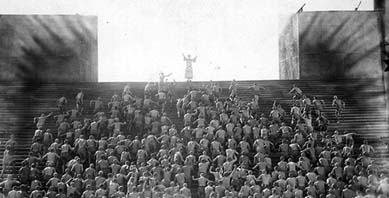
The collapse of occult science and modern science into each other leads to (and emerges from) an especially potent stylistic delirium when Freder, who knows nothing about the construction of the robot, experiences an Oedipal trauma after stumbling upon his father lewdly embracing the false Maria. This causes a nervous breakdown, expressed through a radical montage sequence that’s closer to experimental film than anything else in Lang’s career — a riotous array of uncanny images and subliminal flashes, including direct scratches on the film emulsion that anticipate the work of Stan Brakhage by several decades. (A close runner-up in experimental film technique would be the stretch of animation by Walter Ruttmann three years earlier in Lang’s The Nibelungen — a film that now seems closer to Metropolis in terms of myths as well as metaphysical structures, largely because both films have taken on new dimensions thanks to Patalas’s reconstructions.) This sequence might even be doing something stylistically and psychologically quite close to what the Tower of Babel creates thematically and socially.
The myth of Babel leads one straight back to the pessimism and despair lying just under the surface of the utopian optimism of Lang’s 1926 statement about the “internationalism of filmic language” — his version of cinema as redemption and vision as enlightenment. This is played out with particular fierceness in the sequence in which Rotwang tracks down Maria in the dark catacombs with a flashlight, intending to kidnap her to use as a model for the false Maria; the flashlight, like a film projector’s beam, becomes a precise illustration of vision as voyeurism and as an act of violent aggression.
Jacques Rivette clearly included Metropolis‘s Tower of Babel sequence in his first feature, Paris Belongs to Us — the first serious film quotation in a New Wave film — as a comment on his theme of paranoia, also a staple of Lang’s universe. The dream of a universal language is in some disturbing way a conspiracy scheme, a fascist fantasy — because it assumes that everything in the world can be subsumed in a single meaning and social structure. And the breakdown of that dream and that meaning into chaos, which occurs so hauntingly in Rivette’s film and in Thomas Pynchon’s first three novels, is an allegory telling us something important about what it means to be alive in the 21st century, the century in which Metropolis is set. Fear of sexuality may play as important a role in this gloomy report as fear of science and fear of the past, but a euphoric love of order in all three spheres is what produces Lang’s exciting art and our dangerous idealism.

